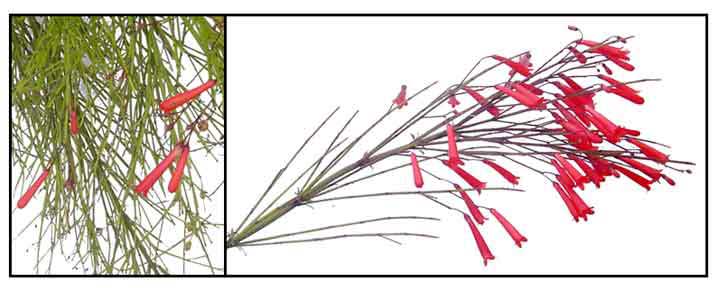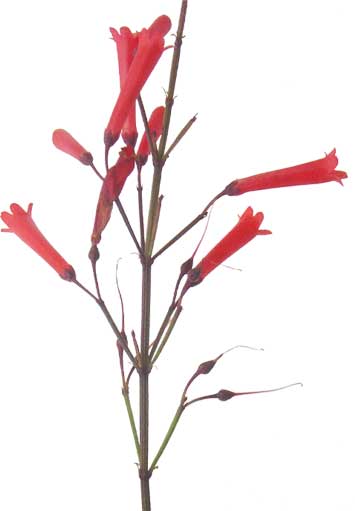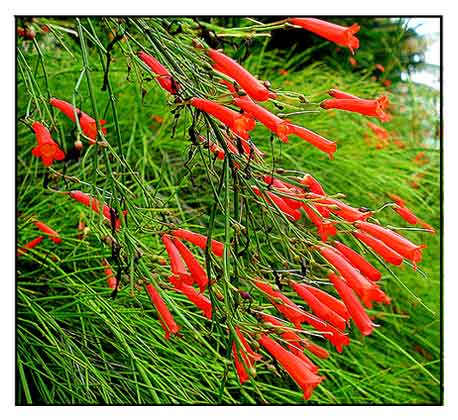|  Gen info Gen info
- The genus Russelia is currently classified as members of the plantain family, Plantaginaceae. In was previously placed in families of Scrophulariaceae or Veronicaceae.
-
Russelia equisetiforis is a species of flowering plant in the family Plantaginaceae.
-
Etymology: The genus name honors Alexander Russell (1715-1768), a naturalist and physician. It was Nikolaus von Jacquin (1727-1817) that gave the genus name. (20)
The species epithet "equisetiformis' derives from Latin, meaning "like equisetum", the horsetail rush.
 Botany Botany
Coral bush is a shrub growing up to 1
meter, low growing with distinctive drooping flower-laden stems. Leaves
are small, linear-lanceolate or ovate and almost scalelike on the branches.
Flowers are red, tubular, 2-lipped, up to 3 cm long and in loose branching
clusters.
Distribution
- Recently introduced to the Philippines.
- Native to Mexico.
Constituents
- Leaves yielded alkaloids, flavonoids, saponins, tannins, steroids, and terpenoids. (see study below)
(9)
- Study of essential oil yielded 20 compounds. The major constituents were
hexadecanoic acid methyl ester 11.04%, 11-methyltetracosane 8.44%, n-docosane 7.66%, α-pinene 7.26%, octadecanoic acid methyl ester 6.37%, eicosanoic acid methyl ester 6.16%, ctadecanoic acid ethyl ester 5.69%, geranic acid 5.60%, methyl tetradecanoate 5.27%, ß-pinene 4.60%. (15)
- Phytochemical screening of extracts and fractions yielded alkaloids, steroids, tannins, terpenoids.
(15)
Properties
- Studies suggest anti-inflammatory, analgesic,
antimicrobial, anticonvulsant, antidiabetic, membrane stabilizing, hair growth-promoting, CNS depressant, anti-malarial, hepatoprotective, anthelmintic properties.
Uses
Folkloric
• No
known folkloric medicinal use in the Philippines.
• In southwestern Nigeria,
used for diabetes and leukemia.
• Used to treat malaria, cancer, and inflammatory diseases.
• Used to promote hair growth.
* In Colombia, decoction of entire plant use for kidney stones.
• In Mexico, infusion of aerial parts used for diabetes. (18)
Others
• Leaf and stem extract of R equisetiformis used as ingredient
in cosmetic products.
 Studies Studies
•
Antimicrobial: Antimicrobial effect of
a methanolic extract was noted on S. aureus, S. albus, S. typhi, P.
aeruginosa and K. edwardsiella. The effect was attributed to triterpenes
in the extract. (1)
• Diabetes
/ Leukemia: Phytochemical
Screening of Cnidoscolus Aconitifolius and Russelia Equisetiformis Used
for the Treatment of Diabetes and Leukemia. (2)
• Antinociceptive:
Results of study of
whole plant extracts effect of Russelia equisetiformis confirmed the
traditional uses of RE in the treatment of inflammation and pain. (3)
•Anti-Inflammatory / Analgesic:
In a study of the methanolic extract of E equisetiformis in rats and mice using carrageenan-induced rat paw edema, acetic acid-induced writhing and tail-flick testing, results suggested that the
extract possesses potential anti-inflammatory and analgesic properties. (4)
• Hair-Growth Promoting Effect: Topical application of the methanol extract of the whole plant of R equisetiformis on a known diameter of shaved area of the back of albino wistar rats produced a significant increase in the rate of hair growth. The hair growth promoting potential is attributed to the presence of triterpenes and flavonoids in the plant extracts. (5)
• Membrane Stabilizing Activity: Study showed the aqueous-ethanol extract of R equisetiformis possess membrane stabilizing activity in a concentration-dependent manner as evidenced by significant changes of membrane stabilization of RBC exposed to heat stress-induced hemolysis. (6)
• Hepatic Function Impairment: Methanol and aqueous extracts of Rusellia equisetiformis were evaluated for effects on hepatic functions. Results showed impairment of liver function with a dose-dependent elevation of enzymes ALT, AST, alkaline phosphatase, with a significant reduction in serum protein. The effects were more pronounced with the methanol extract. (8)
• Antioxidant / Antimicrobial / Cytotoxicity: Study of extract and fractions showed significant antioxidant potential using a DPPH scavenging and linoleic acid oxidation assays. Extracts and fractions also showed antimicrobial activity against selected bacterial and fungal strains. On cytotoxicity testing by hemolytic assay, results showed minor cytotoxicity as percentage lysis of RBCs below 5.0%. (9)
• CNS Depressant Activity: Study evaluated crude methanol extracts and fractions of R equisetiformis in mice using amphetamine-induced stereotypy, picrotoxin-induced convulsion and phenobarbitone sleeping time. Results showed
central nervous system depressant activities. (10)
• Anti-Inflammatory: Study isolated lupeol. The lupeol extract showed significant and dose-dependent anti-inflammatory activity in acute and chronic models of inflammation viz egg albumin-induced paw edema, formaldehyde–induced arthritis and cotton pellet granuloma in-vivo tests. Prednisolone was used standard drug. (11)
• Anticonvulsant: Study of methanol extracts of RE for anticonvulsant activity using picrotoxin (PCT) showed significant protective activity against picrotoxin, probably through GABAergic neurotransmission, and/or facilitating GABAergic action in the brain. Results suggest a potential use as supplementary therapy for management and/or control of childhood convulsions and epilepsy. (12)
• Antimalarial / Plasmodium berghei: Study evaluated the antiplasmodial potential of ethanol extract of Russelia equisetiformis in chloroquine Plasmodium infected mice. Results showed an antimalarial effect with a significant decrease in parasitaemia (p<0.05). Plant extract was devoid of toxicity at highest tested dose of 5000 mg/kg. (13)
• Anthelmintic / Leaves:Study evaluated the in vitro anthelmintic activity of various solvent extracts of Russelia equisetiformis leaves against mature Pheretima posthuma. All solvent extracts exhibited dose-dependent anthelmintic activity. A methanol extract had time of paralysis of 15 min. and death at 27 min. compared to control piperazine citrate with 10 and 13 min, respectively. (16)
• Hepatoprotective / Paracetamol-Induced Toxicity: Russelia equisetiformis exhibited hepatoprotective properties in paracetamol induced toxicity in wistar rats as evidenced by significant reduction (p<0.05) in the levels of biomarkers (AST, ALT, ALP) along with significant changes in hepatic cellular architecture. (17) Administration of paracetamol in rats significantly increased (p<0.05) levels of AST, ALT, ALP, and bilirubin. Treatment with methanol extract of R. equisetiformis significantly reduced (p<0.05) the levels of these parameters in a dose-dependent manner. There were no changes in levels of total protein and albumin. The degree of distortions in liver architecture caused by paracetamol was reduced by extract treatment. (21)
• Silver Nanoparticles / Cytotoxic / Antibacterial / Leaves: Study reports on the eco-friendly fabrication of silver NPs using organic phytomolecules from Russelia equisetiformis and Leucophyllum frutescens leaves extract as capping and reducing agents added to AgNO3. Reduction in cancer cell viability with low half-maximal inhibitory concentrations was noted for both tested NOs, with structural changes and apoptotic features in the treated cancer cell lines. Higher antibacterial activity was noticed against Gram-positive bacteria as well as high synergistic effect for Amp-NPs conjugate. (20)
Availability
Wild-crafted. |


 Gen info
Gen info Botany
Botany


